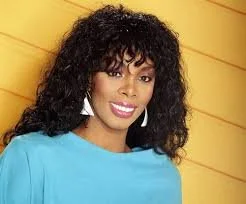3 Top-Tier Black American Women Singers Came To Germany
Donna
Chaka
Tina
The movement or relocation of black American intellectuals, visual and performance artists to Europe is not a novelty. It has been the norm as far back as the 19th century, when racism and segregation was pungent and contaminant enough to deoxygenate the life force and threaten the careers of affected persons. Many artists moved to locations where their craft was appreciated and their personhood respected. Such artists included Josephine Baker, James Baldwin, Langston Hughes, Hazel Scott, etc.
While the favourite location tended to be France, many performance artists also sojourned countries like England, Netherlands and Belgium. The iconic Nina Simone fled the USA in the 1960s to escape state surveillance following her musical subversion against the status quo for perpetuated racism and persecution of African Americans. She moved from England to Netherlands and eventually settled in France. Marvin Gaye went on a sabbatical in Belgium from 1981 to 1982, to reflect, regain inner peace and self-rehabilitate from drugs. The song “Sexual Healing” was an outcome of that break. Jody Watley lived in London, England in the mid-1980s to recalibrate, reimagine and restrategize the future of her career in the aftermath of her Shalamar-exit. In 1984, she would be invited to be a part of Robert Geldof’s Band Aid project which featured the song “Do They Know It’s Christmas?”.
It would seem that Germany was rarely an attractive spot for these artists, but that is further from the truth. Infact, in the late 19th century, Germany hosted a plethora of performers, singers, dancers and artists. The Fisk Jubilee Singers toured the country in the autumn of 1877 where they sang in the central Berlin Cathedral and entertained the royal family in Potsdam. They are credited for first introducing Germans to the African American music traditions like the Spirituals, etc.
They were also the Cakewalkers renowned for their luxurious self-presentation. The Cakewalk dance conceptualized by enslaved African Americans, parodized the white slaveholding upper class and was well-received by the Germans, perhaps out of their curiosity about racial difference. And since entertainers enjoyed better pay and favourable work conditions, many African- American entertainers moved to Berlin like Dora Dean, Charles Johnson, Emma Harris, Arabella Fields,The Anderson Siblings, Louis Douglas, etc.
Douglas, the bluesman from Philadelphia also wrote for Berlin’s culture magazine Revue des Monats (Review of the Month). The Berlin socioculture is said to have been heavily influenced by the presence of African American artists at the time. And on the other hand, the artists were influenced by their new environment and borrowed creative inspiration from the aforementioned. For instance, the Four Black Diamonds, a quartet often closed their performances with a “Tirol Number” which showcased a rhythmic improvisation in the Bavarian dialect. This was a marker of cultural assimilation and belonging.
With the outbreak of World War 1 in 1914, a greater majority of African Americans left Germany and would return in 1924 following economic revampment with a retinue of younger performers. Entertainer/Producers like Louis Johnson and Will Garland facilitated a re-enactment of the Black revue, a touring variety show galvanized by New York’s Black musical theatre which was an incorporation of minstrelsy idioms entertwined with the duplication of colonialized vocabulary of human zoos, thereby replicating the racialized experience and stereotypes of that period. Josephine Baker would become the face of the Revue with a debut in 1925 which featured Douglas, himself as the male lead.
In the embryonic stage of the National socialism (Nazi), these black stereotypical roles were weaponized to propagate the Nazi’s racial ideology and amidst state repression, majority of African Americans departed Germany. Following the outbreak of World War 2 and Germany’s defeat, a new batch of Americans trooped into the country.
In the wake of her loss, Germany was partitioned into 4 allied occupation zones. Whereas the USSR took charge of the eastern region, the US/ UK and France collaboratively occupied the western zone. The overseers brought in their throes, their political ideologies whereby the east became communist while the west assimilated western capitalism.
Following the reunification of Germany in 1989, all but the American troops withdrew. Of all its military operations across the world, the US has the largest force in Europe stationed in Germany. It boasts about 35, 000 troops across 20 military installations. Germany’s central position in Europe, geographically and politically factors in this development which enables American military projections across Europe, Africa and the Meditteranean. Consequently, this politcal equation places Americans black and white and American culture atop the German’s collective mental hierarchy.
Americans are revered and highly esteemed. The American culture permeates the walls of the German society in music, fashion, film, and political calculations. The American black, for instance, is romanticized and almost deified in contrast to blacks from other geographical regions. The black American’s citizenship nullifies and compensates for his blackness and he can do no wrong in the German’s eye.
In comes LaDonna Gaines, who the world would come to know as Donna Summer. She would perhaps be the first known black American entertainer in contemporary times to be linked to Germany. As a part of the cast in Haare (“hair” in English), a musical theatre production which presented a great career opportunity for Donna, she chose the German adaptation from other options like the France and London productions due to her genetic connection to Germany. Her father, Andrew, had served in the country during World War 2.
For about seven years, she resided in Munich, where she portrayed the female lead , Sheila in Haare and wore a bogus afro. She also appeared in other local productions like Godspell, The Me Nobody Knows, Porgy and Bess, and Showboat. She was briefly a member of the Vienna Volksoper opera company in Austria. She did session work for experimental European electronic groups like Tangerine Dream and Kraftwerk (“power station” in English) which would facilitate her meeting in 1973 with synth-pop producer and studio owner, Giorgio Moroder; British songwriter and producer, Pete Bellotte and musician/songwriter, Harold Faltermeyer. This encounter would mark the advent of her emergence as a global music icon with the aural sex song “Love to Love You Baby”.
She would also marry Helmuth Sommer, an Austrian actor. Sommer means “summer” in English and this would become her stage name.
While Summer was relishing her stardom in the 1970s, Yvette Marie Stevens, soon to be known as Chaka Khan was a budding performer in local gigs around Chicago. In 1972, she was spotted by two members of Rufus and would replace Paulette McWilliams, the lead singer. Her musicianship was profound that many including Ike Turner took notice. She would go solo in 1978 with a successful debut album which had hit single “Every Woman”. The 1980s became her peak period as she charted with incredible and unforgettable songs like “I Feel for You”, “Through the Fire”, etc.
With fame and success came an excessive drug indulgence which engendered a movement to Germany for self-rehabilitation in the mid-1980s. There is scanty information in the public space about this period of her life. However, it is known that she resided in a village in the Rhine Valley and also in Mannheim, a city in Baden- Württenberg in the southwestern part of Germany with her German TV producer boyfriend.
Tina Turner on the other hand met her second husband, German music executive Erwin Bach in the mid-80s, in the course of work in Dusseldorf, North-Rhine Westphalia. He was sent by her Music Label, EMI to receive her at the airport. For romantic reasons, Turner moved from the US in the 1980s to Cologne in the same State where both lived and later relocated to Switzerland. They dated for 27 years and eventually married in 2013.
These singers are beloved and well-known in the German media and public spaces. Apart from Michael Jackson, Janet Jackson, Mary J. Blige, Whitney Houston, Beyonce, their music enjoys regular rotation on local radios and has a special place in the hearts of the German collective. On the whole, the German society is well acquainted with innumerable Black American entertainers who in times past were regularly hosted by German’s top show host, Thomas Gottschalk on his syndicated TV show Wetten, dass…? which he anchored from 1987 to 2010.
Reference:
Pomeranz, Deborah. African American Performers 1877- 1933. Stadtmuseum Berlin.





